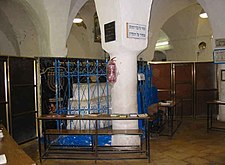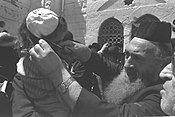Tomb of Rabbi Shimon bar Yochai
It has been suggested that Hillula of Rabbi Shimon bar Yochai be merged into this article. (Discuss) Proposed since May 2021. |
קבר רבי שמעון בר יוחאי | |
 Entrance to the tomb of Rabbi Shimon bar Yochai | |
| Alternative name | Kever Rashbi |
|---|---|
| Location | Meron, Israel |
| Region | Galilee |
| Coordinates | 32°58′51.2″N 35°26′26.3″E / 32.980889°N 35.440639°ECoordinates: 32°58′51.2″N 35°26′26.3″E / 32.980889°N 35.440639°E |
| Type | tomb |
| Site notes | |
| Ownership | Private |
| Management | Ministry of Religious Services[1] |
| Public access | Yes |
The tomb of Rabbi Shimon bar Yochai, or Kever Rashbi, on Mount Meron is the traditional burial place of the 2nd century Mishnaic rabbi. A place of pilgrimage since at least the 13th century,[2] it is today one of Israel's most famous tombs and the second most visited Jewish site in the world after the Western Wall[3] with as many as two million annual visitors.[4]
The tomb building was built in the mid-19th century by Shmuel Abu, the French consular agent in Safed.[5]
History and structure[]

In the 12th century, Yaakov ben Netanel Hacohen, who wrote a travel diary of his visit to Palestine, wrote that there is a tomb for Rabbi Shimon Bar Yochai and his son in Meron.[6] According to historian Elhanan Reiner, the tomb was managed by Musta'arabi Jews even before the expulsion from Spain and establishment of the Spanish Jewish community in Israel in the 16th century.[7]
Abraham ben Mordecai Galante is said to have built a mausoleum over the tomb on the recommendation of Isaac Luria.[8]
At the beginning of the 19th century, the area was purchased by Shmuel Abu, the French consular agent in Safed who had immigrated from Algeria in 1817. Shmuel Abu built the tomb building which now stands on the site.[5][9] The tomb building was described in the late 19th century PEF Survey of Palestine as "apparently a modern building."[10]
The large tomb structure has recognizable light blue domes[11] and includes several rooms. In the large room in the southern corner is a tombstone marking the tomb of Rabbi Shimon Bar Yochai. In the center of the room is another tombstone marking the tomb of Rabbi Eleazar, the son of Rabbi Shimon Bar Yochai.
Ownership[]
Ownership of the site is contested between rival Sephardic and Ashkenazic trusts, both of whom claim full ownership of the entire area citing hundreds of years’ precedent. Appeals to the courts have failed to settle the issue and the feud has allowed very little development to take place resulting in substandard facilities and safety concerns, the structure surrounding the tomb having become old and neglected. Millions of dollars in funding for redevelopment and refurbishment of the location were bequeathed by philanthropist Edmond Safra, but the quarreling between the parties is holding up release of the funds.[12] An attempt by the state to take control over the site in 2011 to address health and safety concerns[13] was met with anger by the private endowments operating the site and a court approved settlement in 2020 ruled that control would remain with the owners.[14]
Annual pilgrimage[]
Every year on Lag BaOmer, a traditional pilgrimage is made to the tomb, marking Rabbi Shimon bar Yochai's 'Yom Hillula'. The highlight of the event is the lighting of a bonfire at night on the roof of the tomb, after which joyous dancing begins. From the 13th century onwards, the site became the most popular Jewish pilgrimage site in all of Palestine[15] and today the annual event is the largest annual mass gathering in Israel. Various government bodies invest considerable sums of money and manpower resources to maintaining order and ensure the flow of traffic to the site.
In 1949, Rabbi Moshe-Zvi Neria organized a mass pilgrimage to the tomb following the Israeli victory in the 1948 Arab–Israeli War. This became the basis for an annual pilgrimage on 7 Adar, in addition to Lag BaOmer.[16]
Bonfires[]
At the tomb of Rabbi Shimon, the honour of lighting the main bonfire traditionally goes to the Rebbes of the Boyaner dynasty. This privilege was purchased by Rabbi Avrohom Yaakov Friedman, the first Sadigura Rebbe, from the Sephardi guardians of Meron and Safed. The Sadigura Rebbe bequeathed this honor to his eldest son, Rabbi Yitzchok Friedman, the first Boyaner Rebbe, and his progeny.[17] The first hadlakah (lighting) is attended by hundreds of thousands of people annually; in 2001, the crowd was estimated at 300,000.[18]
First haircut for boys[]

It is customary at the Meron celebrations, dating from the time of Rabbi Isaac Luria, that three-year-old boys be given their first haircuts (upsherin), while their parents distribute wine and sweets. Similar upsherin celebrations are simultaneously held in Jerusalem at the grave of Shimon Hatzaddik for Jerusalemites who cannot travel to Meron.[19]
Chai rotel liquid refreshment gift[]
Another custom at the tomb of Rabbi Shimon bar Yochai is the giving of Ḥai Rotel (Hebrew: ח״י רוטל). The Hebrew letters chet and yod are the gematria (numerical equivalent) of 18. Rotel is a liquid measure of about 3 litres. Thus, 18 rotels equals 54 litres or about 13 gallons. It is popularly believed that if one donates or offers 18 rotels of liquid refreshment (grape juice, wine, soda or even water) to those attending the celebrations at bar Yochai's tomb on Lag BaOmer, then the giver will be granted miraculous salvation.[20]
According to Taamei Minhagim, many childless couples found success with this segula (propitious practice). This practice was also endorsed by Rabbi Ovadia miBartenura[21] and The Shelah HaKadosh.[22] The Bobover Rav, Ben Zion Halberstam sent a letter from Poland to his Chassidim in Israel asking them to donate chai rotel in Meron on this holy day on behalf of a couple that did not have children.[22] Several local organizations solicit donations of chai rotel and hand out the drinks on the donor's behalf in Meron on Lag BaOmer. Nine months after Lag BaOmer, the Ohel Rashbi organization even invites couples who prayed at the tomb and had a child to come back to Meron to celebrate the births.[21]
Incidents[]
1911 collapse[]
On 15 May 1911, eleven people were killed when a crowd of about 10,000 filled the compound and a railing of a nearby balcony collapsed. About 100 people fell from a height of roughly seven meters to the ground below,[23] the deaths of seven were determined at the scene and of four others in the days following the incident. There were 40 injured.[3]
2021 stampede[]
On 30 April 2021, at about 00:50 IDT, a deadly crowd crush occurred in Meron during the annual pilgrimage to Mount Meron on the Jewish holiday of Lag BaOmer, at which about 100,000 people were in attendance. Forty-five people were killed, and more than 150 injured, dozens of them critically, making it the deadliest civil disaster in the history of Israel.
Gallery[]

Lag BaOmer, 1939

Dome above tomb

Crowds at the tomb

Aerial view of the complex
See also[]
- Lag BaOmer
- 2021 Meron crowd rush
References[]
- ^ Shafir, Nitsan (2 May 2021). "Blame game begins after Meron disaster". Globes. Retrieved 4 May 2021.
- ^ Benayahu, Meir. "Devotion Practices of the Kabbalists of Safed in Meron". Sefunot: Studies and Sources on the History of the Jewish Communities in the East / ספונות: מחקרים ומקורות לתולדות קהילות ישראל במזרח: 5–29. JSTOR 23415184.
- ^ a b "110 years ago, 100 people fell from a balcony at Mt. Meron; 11 were killed". The Times of Israel. 1 May 2021. Retrieved 2 May 2021.
- ^ Dignity, Edmond J. Safra Philanthropic Foundation, (2015). pg. 95.
- ^ a b Gonen, Rivka (1999). "Reclaiming the Site of bar Yohai's Tomb and Construction of the Building". To the Tombs of the Righteous: Pilgrimage in Contemporary Israel. Israel Museum. ISBN 978-965-278-236-6.
- ^ יערי, אברהם. מסעות ארץ ישראל (in Hebrew). p. 58.
- ^ אשכנזי, אלי (2 July 2010). "ההיסטוריון אלחנן ריינר : לא תיתכן בעלות ספרדית או אשכנזית על קבר בר יוחאי" (in Hebrew). Ha'aretz. Retrieved 2 May 2021.
- ^ Franco, M.; Kohler, Kaufmann; Broydé, Isaac; Deutsch, Gotthard. Galante. Jewish Encyclopedia. Retrieved 2 May 2021.
- ^ Tidhar, David. Entsiklopedyah le-halutse ha-yishuv u-vonav (Vol. 1) (in Hebrew). p. 310. Retrieved 2 May 2021.
- ^ PEF Survey of Palestine, Vol 1, p.253: "There are also the traditional tombs of Rabbi Shammai and of Rabbi Simeon Ben Jochai ; the latter is much venerated, and pilgrimages are made to the tomb, which is apparently a modern building."
- ^ "Tomb of the Rashbi". Lonely Planet. Retrieved 2 May 2021.
- ^ Nathan Jeffay. (May 15, 2008). At Grave of Famed Rabbi, Feuding Trustees Find Little Common Ground, Forward.
- ^ "הממשלה החליטה להלאים את קבר הרשב"י". Haaretz. 27 November 2011. Archived from the original on 2 May 2021. Retrieved 30 April 2021.
- ^ "המהלך להפקעת מתחם קבר הרשבי במירון נעצר; במקומו – הסדר ל-3 שנים". www.nadlancenter.co.il. Archived from the original on 2 May 2021. Retrieved 30 April 2021.
- ^ Horden, Peregrine; Purcell, Nicholas (2000), The Corrupting Sea: A Study of Mediterranean History, Blackwell Publishing, ISBN 9780631218906, p. 446: "From the thirteenth century the most frequented pilgrim shrine for Jews in Palestine was at Meiron in Galilee… While it was a prominent local religious centre in late Antiquity, with a fine synagogue built in a conspicuous position and a much-venerated copies spring, it had then nothing like the status which it would acquire in the Middle Ages."
- ^ "ניגון הדבקות של חטיבה 7 / זאב אלק". מוסף שבת. Retrieved 2 May 2021.
- ^ Rossoff, Dovid (2005). קדושים אשר בארץ: קברי צדיקים בירושלים ובני ברק [The Holy Ones in the Earth: Graves of Tzaddikim in Jerusalem and Bnei Brak] (in Hebrew). Jerusalem: Machon Otzar HaTorah. pp. 315–316.
- ^ Brayer, Rabbi Menachem (2003). The House of Rizhin: Chassidus and the Rizhiner Dynasty. Mesorah Publications. p. 435. ISBN 1-57819-794-5.
- ^ Rossoff, Dovid. "Meron on Lag B'Omer". The Jewish Magazine. Retrieved April 28, 2010.
- ^ Lebovits, Moishe Dovid. "Lag BaOmer". Halachically Speaking. p. 6. Retrieved 27 April 2010.
- ^ a b "Over 500,000 Expected in Meron for Lag Ba'omer, 5769". matzav.com. 2009-05-11. Retrieved 2010-04-28.
- ^ a b "Chai Rotel Segulah". YeshuosRashbi.com. Retrieved 14 April 2013.
- ^ Maltz, Judy (30 April 2021). "Why do Orthodox Jews flock to the Mt. Meron tomb of Rabbi Shimon Bar-Yochai?". Haaretz.com. Archived from the original on 2 May 2021. Retrieved 30 April 2021.
- Galilee
- Jewish pilgrimage sites
- Jews and Judaism in the Roman Empire
- Lag BaOmer
- Tombs in Israel




